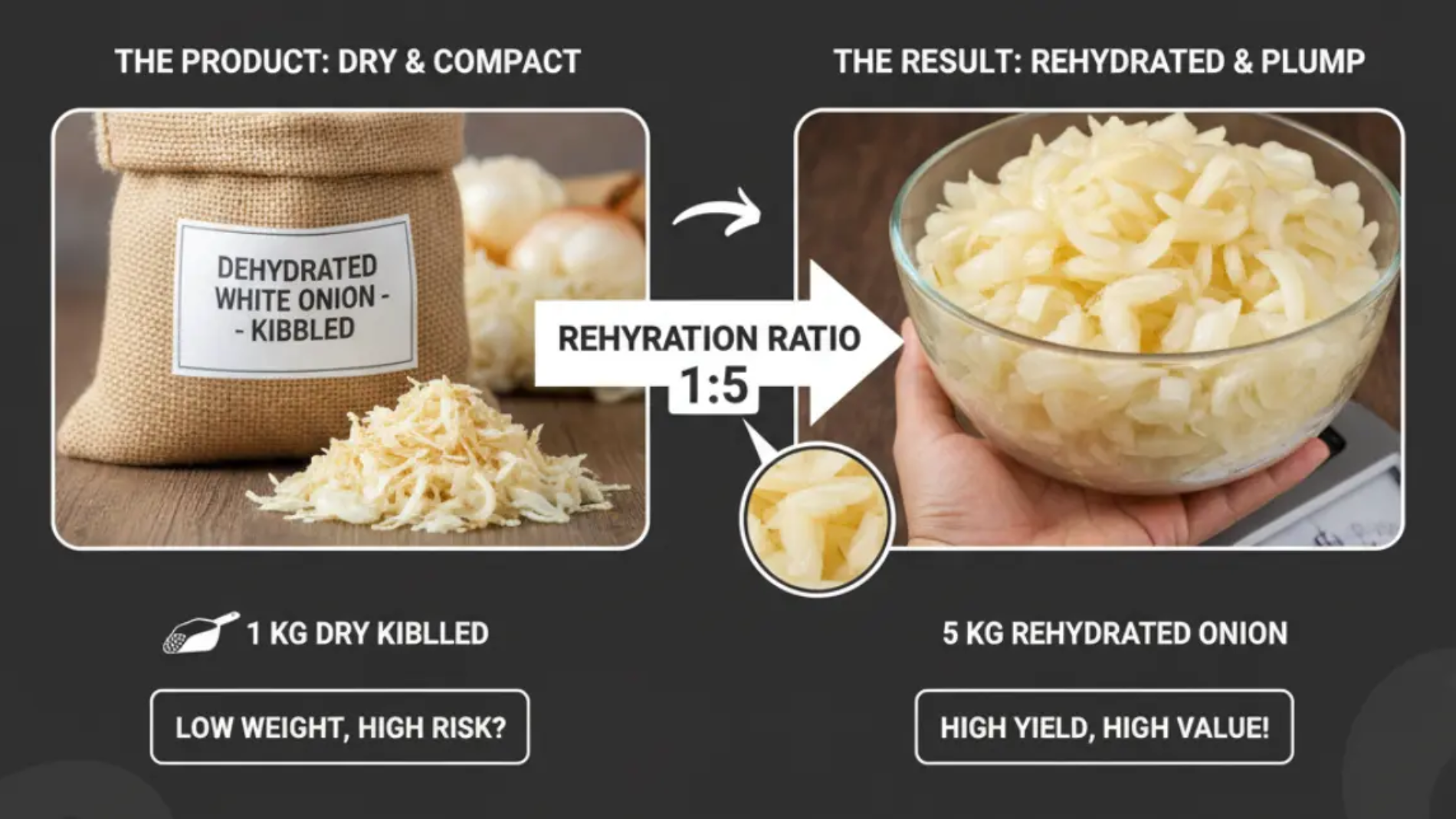For food manufacturers and importers sourcing dehydrated vegetables, the specification sheet is a critical document. It’s filled with essential data points like moisture content, particle size, and purity. However, there is one metric, particularly for products like Onion Kibbled, that is often overlooked but holds the key to product performance and profitability: the rehydration ratio.
While price per kilo and visual appearance are important, the rehydration ratio is a true measure of an ingredient’s quality and value. As an experienced onion supplier in India, we know that savvy buyers understand this metric is a direct indicator of processing quality and final product yield. This guide explains what the rehydration ratio is and why it’s a key metric you cannot afford to ignore.
What is Rehydration Ratio?
Simply put, the rehydration ratio measures how much weight the dehydrated product gains when it absorbs water. It is expressed as a ratio, such as 1:5. This means that for every 1 gram of dry Onion Kibbled, you will get 5 grams of rehydrated onion after soaking it in water for a specified time.
This metric is the ultimate test of how well the dehydrated onion was processed and how effectively it can return to a state resembling fresh, cooked onion.
1. A Direct Indicator of Superior Processing Quality
A high rehydration ratio is a sign of a gentle and sophisticated dehydration process. When onions are dried slowly and at controlled temperatures, their cellular structure remains largely intact. These undamaged cells can effectively absorb water again, allowing the kibbled pieces to swell, become tender, and regain a texture similar to freshly chopped onion.
Conversely, a low rehydration ratio is a red flag. It indicates an aggressive, high-heat drying process that has damaged or collapsed the onion’s cell walls. These damaged cells cannot properly absorb water, resulting in a product that remains tough, chewy, or leathery even after soaking.
Spice Up Your Business with Authentic Indian Flavors
Import and Export Excellence from India!

2. The Key to Better Yield and Cost-Effectiveness
For food manufacturers, this is where the rehydration ratio has a direct impact on the bottom line. It’s a simple calculation of yield.
Imagine you are sourcing 100 kg of Onion Kibbled for a large batch of soup.
Supplier A offers a premium product with a 1:5 rehydration ratio. Your 100 kg of dry kibbled yields 500 kg of rehydrated onion for your recipe.
Supplier B offers a cheaper product with a 1:3 rehydration ratio. Your 100 kg of dry kibbled yields only 300 kg of rehydrated onion.
In this scenario, the “cheaper” product from Supplier B is actually far more expensive in terms of its functional value and final yield. A higher rehydration ratio means you are getting more usable product for your money.
3. Superior Texture, Mouthfeel, and Flavor Release
The goal of using Onion Kibbled in products like stews, canned goods, and dry soup mixes is to provide a pleasant, soft texture that mimics real onion pieces.
A high rehydration ratio ensures this. The kibbled pieces become tender and succulent, enhancing the overall mouthfeel of the final product. A poorly rehydrated onion, on the other hand, will be tough and fibrous, creating an unpleasant eating experience for the consumer. Furthermore, proper rehydration allows the onion’s natural, pungent flavor compounds to be released more effectively into the surrounding broth or sauce, resulting in a more flavourful dish.
How to Verify the Rehydration Ratio
You don’t have to take a supplier’s word for it. Verification is straightforward.
Ask the Supplier: A professional dehydrated onion supplier will have the rehydration ratio clearly stated on their technical specification sheet.
Request a Sample Test: The best way to verify is to test it yourself. Take a precise weight of the dry kibbled onion (e.g., 10 grams), soak it in warm water for 30-60 minutes, drain the excess water thoroughly, and then weigh the rehydrated product. This simple test will give you the real-world ratio and confirm the supplier’s quality claims.
Spice Up Your Business with Authentic Indian Flavors
Import and Export Excellence from India!

The Right Format for the Right Application
While a high rehydration ratio is critical for Onion Kibbled, it’s also important to know when a different format is needed. For applications that require a completely smooth texture and instant flavour dispersion—such as creamy dressings, fine marinades, or snack food coatings—rehydration isn’t the goal. In these cases, a fine onion powder is the superior choice, as it dissolves and integrates immediately.
By understanding the rehydration ratio, importers can make smarter, more profitable sourcing decisions, ensuring the Onion Kibbled they purchase delivers not just on price, but on performance.
Frequently Asked Questions (FAQs)
1. What is a good rehydration ratio for export-quality onion kibbled?
For high-quality Onion Kibbled, you should look for a rehydration ratio of at least 1:4 to 1:5. Anything lower may indicate inferior processing.
2. Does the rehydration ratio affect the onion’s flavor?
Yes, indirectly. A better rehydration means the onion cells are healthier and can release their natural flavour compounds more effectively into the dish, resulting in a more potent and authentic taste.
3. Will a higher ratio product cost more?
Initially, a product with a guaranteed high rehydration ratio may have a higher price per kilo. However, as it provides a greater final yield, its “cost-in-use” is often significantly lower, making it more economical for manufacturers.
4. How is the rehydration ratio tested in a lab?
It is tested under controlled conditions, where a specific weight of the product is soaked in water at a specific temperature for a set amount of time before being drained and re-weighed.
5. Does particle size (kibbled vs. minced) affect the rehydration ratio?
Generally, different particle sizes from the same quality raw material will have similar rehydration ratios, as it’s a measure of cellular integrity. However, smaller particles like minced onion may rehydrate slightly faster than larger kibbled pieces.
6. Is this metric also important for other dehydrated vegetables?
Absolutely. The rehydration ratio is a key quality metric for many dehydrated vegetables, including garlic, carrots, and bell peppers, for the same reasons: it indicates quality, yield, and final texture.
7. Does the color of the onion kibbled relate to its rehydration ability?
A good, uniform off-white color is a sign of a well-controlled, gentle drying process. A scorched or brown color indicates high-heat drying, which is the same process that damages cell walls and leads to a poor rehydration ratio.
8. For which products is the rehydration ratio NOT important?
The ratio is not relevant for onion powder, as its function is to dissolve or disperse for flavour, not to provide texture. For granules used in dry rubs, flowability is more important than their ability to rehydrate.
About us
We bridge the gap between local producers and global markets, ensuring seamless trade facilitation with exceptional quality and reliability. We provide quick delivery services with customized packaging with all approval of International Certificates (Spices board India, MSME, IEC, fssai, FIEO, APEDA, EU certification, FDA and Many More)
Contact us
Shop No. 3, Ganesh Prestige Sr. No. 2/15, Near Laxmi Jewellers, Dhanakawadi, Pune – 411043, Maharashtra INDIA.
Call On
+91 9545205050
+91 9822422584



Leave A Comment